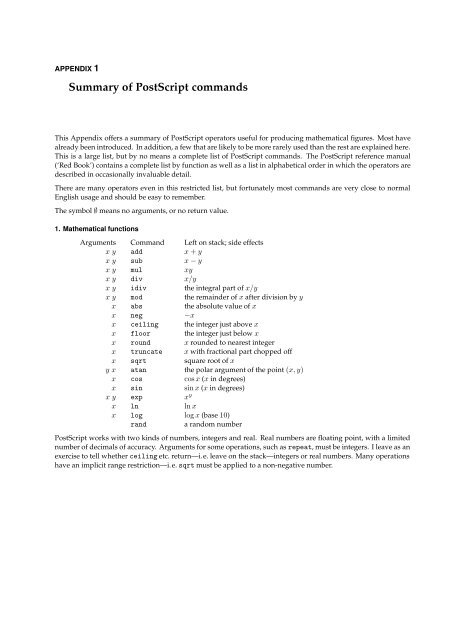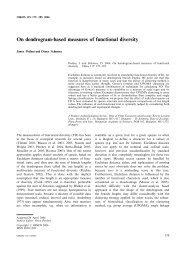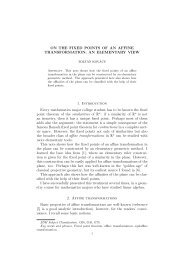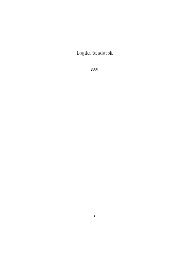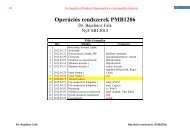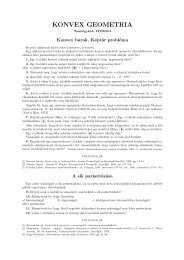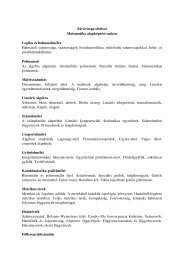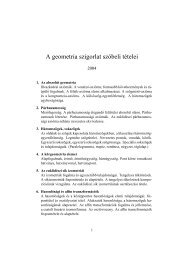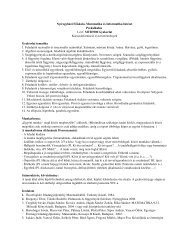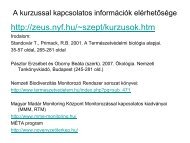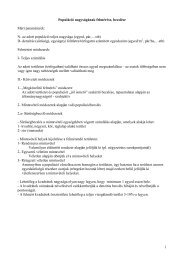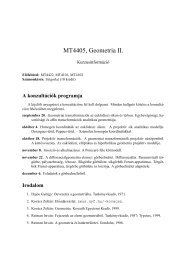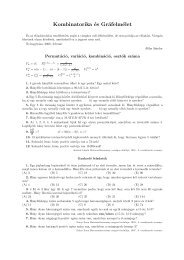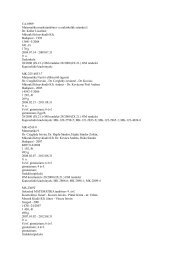Summary of PostScript commands
Summary of PostScript commands
Summary of PostScript commands
Create successful ePaper yourself
Turn your PDF publications into a flip-book with our unique Google optimized e-Paper software.
APPENDIX 1<strong>Summary</strong> <strong>of</strong> <strong>PostScript</strong> <strong>commands</strong>This Appendix <strong>of</strong>fers a summary <strong>of</strong> <strong>PostScript</strong> operators useful for producing mathematical figures. Most havealready been introduced. In addition, a few that are likely to be more rarely used than the rest are explained here.This is a large list, but by no means a complete list <strong>of</strong> <strong>PostScript</strong> <strong>commands</strong>. The <strong>PostScript</strong> reference manual(‘Red Book’) contains a complete list by function as well as a list in alphabetical order in which the operators aredescribed in occasionally invaluable detail.There are many operators even in this restricted list, but fortunately most <strong>commands</strong> are very close to normalEnglish usage and should be easy to remember.The symbol ∅ means no arguments, or no return value.1. Mathematical functionsArguments Command Left on stack; side effectsx y add x + yx y sub x − yx y mul xyx y div x/yx y idiv the integral part <strong>of</strong> x/yx y mod the remainder <strong>of</strong> x after division by yx abs the absolute value <strong>of</strong> xx neg −xx ceiling the integer just above xx floor the integer just below xx round x rounded to nearest integerx truncate x with fractional part chopped <strong>of</strong>fx sqrt square root <strong>of</strong> xy x atan the polar argument <strong>of</strong> the point (x, y)x cos cosx (x in degrees)x sin sin x (x in degrees)x y exp x yx ln ln xx log log x (base 10)randa random number<strong>PostScript</strong> works with two kinds <strong>of</strong> numbers, integers and real. Real numbers are floating point, with a limitednumber <strong>of</strong> decimals <strong>of</strong> accuracy. Arguments for some operations, such asrepeat, must be integers. I leave as anexercise to tell whetherceiling etc. return—i.e. leave on the stack—integers or real numbers. Many operationshave an implicit range restriction—i.e.sqrt must be applied to a nonnegative number.
Appendix 1. <strong>Summary</strong> <strong>of</strong> <strong>PostScript</strong> <strong>commands</strong> 22. Stack operationsx pop ∅x y exch y xx dup x xx n−1 . . . x 0 n i roll x i−1 . . .x 0 x n−1 . . . x iThis rolls the top n elements on the stack around by a shift up <strong>of</strong> i elements. For example, if the stack holds 12 3 4 5 (from the bottom up) then5 2 roll changes it to 4 5 1 2 3. It is more efficient if more complicatedto do stack operations than access them by variable names, although the extra efficiency is <strong>of</strong>ten not worth theinconvenience <strong>of</strong> having to keep track <strong>of</strong> what’s what on the stack.x n−1 . . .x 0 n copy x n−1 . . . x 0 x n−1 . . . x 0A good trick for debugging is to combine copy and roll to view in a terminal window the top n items on thestack. The best way to do this (where n = 3):3 copy [ 4 1 roll ] ==3. Arraysx i . . . x 0 i index x i . . . x 0 x i[ begins an array] closes an arrayan array a length number <strong>of</strong> items in the array aa i get a ia i x put −Sets the ith entry <strong>of</strong> a equal to x. The way to remember the order <strong>of</strong> the arguments here is to think <strong>of</strong> this asformally equivalent toa[i] x def.a i j getinterval a i . . . a jn array an empty array <strong>of</strong> length n withnull entriesThenull item in <strong>PostScript</strong> is like nothing . . . else.a aload a 0 . . . a l−1 a (l is the length <strong>of</strong> a)This essentially just unpacks a onto the stack, but also puts a itself on top. If you want just to unpack a, use thepairaload pop.An array in <strong>PostScript</strong> is what in other languages is called a pointer, which is to say it is stored in <strong>PostScript</strong> as anaddress in the machine where the items in the array are stored. The practical importance <strong>of</strong> this is that if a is anarray then the sequencea dup doesn’t make a new copy <strong>of</strong> the data stored by a, but only a copy <strong>of</strong> the addresswhere the data is stored. The sequencea [ exch aload pop ]will make a new array with the same data as a.4. Dictionariesname item def makes an entry in the current dictionaryn dict puts a dictionary <strong>of</strong> n null entries on the stackdictionary d begin opens d for useendcloses the last dictionary openedDictionaries in <strong>PostScript</strong> keep track <strong>of</strong> variable names and their current values. There may be several dictionariesin use at any moment; they are stored on a stack (the dictionary stack) and searched from the top down. Thecommandbegin puts a dictionary on this stack andend pops it <strong>of</strong>f. Sobegin andend should be nested pairs.
Appendix 1. <strong>Summary</strong> <strong>of</strong> <strong>PostScript</strong> <strong>commands</strong> 3something bind used beforedef to construct a procedure immediatelyNormally, when defining a procedure, the names occurring in it are left as strings, without attempting to look uptheir values when the definition is made. These names are looked up when the procedure is called. But whenbind is used, the names that do occur in dictionaries are evaluated immediately.5. ConditionalsThe first few return ‘boolean’ constantstrue orfalse. A few others have boolean values as arguments.6. Loopsfalse false (boolean constant)true true (boolean constant)x y eq x = y?x y ne x ≠ y?x y ge x ≥ y?x y gt x > y?x y le x ≤ y?x y lt x < y?s t and s and t are both true?s t or at least one <strong>of</strong> s and t is true?s not s is not true?s { . . . } if executes the procedure if s is trues { . . . }{ . . . } ifelse executes the first procedure if s is true, otherwise the secondi h f { . . . } for steps through the loop from i to f, incrementing by hThe tricky part <strong>of</strong> this is that at the start <strong>of</strong> each loop it leaves the loop variables i, i + h, i + 2h on the stack. It issafest to use this only with integer loop variables.n { . . . } repeat executes the procedure n times{ . . . } loop executes the procedure untilexit is called from within the procedure∅ exit exits the loop it is contained in∅ quit stops everythinga { . . . } forall loops through the elements <strong>of</strong> a, leaving each in turn on the stack{.}{.}{.}{.} pathforall loops through the current path (see below)The four arguments topathforall are procedures to be called in the course <strong>of</strong> looking at the current path. Thisis a tricky command, but it can produce spectacular effects. A path is a special kind <strong>of</strong> array. Each element in it isone <strong>of</strong> the four <strong>commands</strong>x y moveto,x y lineto,x[1] y[1] x[2] y[2] x[3] y[3] curveto,closepath.The data are expressed in device coordinates. The command pathforall loops through the elements <strong>of</strong> thecurrent path, pushing its arguments on the stack and then executing the corresponding procedure. For example,the following segment displays the current path.{ [ 3 1 roll (moveto) ] == }{ [ 3 1 roll (lineto) ] == }{ [ 7 1 roll (curveto) ] == }{ [ (closepath) ] == }pathforallThe values <strong>of</strong> the coordinates are in the current user coordinates.7. Conversionsx s cvs an initial substring <strong>of</strong> the string s expressing xx cvi x converted to integer
Appendix 1. <strong>Summary</strong> <strong>of</strong> <strong>PostScript</strong> <strong>commands</strong> 48. File handling and miscellaneousThusa string s run executes the file sshowpage changes a pagea procedure exec executes a procedurea name load loads the value associated to the name− save puts a copy <strong>of</strong> the entire current state on the stackstate restore restores the state on the stacksave /SavedState exch def...SavedState restorewill save and restore a snapshot <strong>of</strong> a state.typetells what type the object at the top <strong>of</strong> the stack isIt pops that object from the stack, so you will likely want to usedup and type together. This is one <strong>of</strong> the morecomplicated <strong>PostScript</strong> operators. First <strong>of</strong> all, what it returns is one <strong>of</strong> the following namesarraytype an arraybooleantype a boolean liketrue orfalsedicttype a dictionaryfonttype a fontintegertype an integer like 1marktype a[nametype a name like/xnulltype a null objectoperatortype an operator likeaddrealtype a real number like 3.14159stringtype a string like(x)or possibly one <strong>of</strong> a few types I haven’t introduced.Second, what it returns is an executable object, which means if you apply to it theexec operator it will executewhatever has been defined by you to be associated to that name. Thus after/arraytype { dup length = == } def/integertype { = } defthe sequence dup type exec will display and pop the object at the top <strong>of</strong> the stack if it is an integer, displayand pop it and its length if it is an array, and give you an undefined error otherwise. This allows you to havea procedure do different things, depending on what kind <strong>of</strong> arguments you are passing to it. The <strong>PostScript</strong>operatortransform behaves like this, for example, detecting whether the top <strong>of</strong> the stack contains a matrix or anumber.9. Displayx = pops x from the stack and displays it on the terminalx == almost the same as=The most important difference between the two is that the operator == displays the contents <strong>of</strong> arrays, while =does not. One curious difference is how they handle strings. Thus (x) = displays x in the terminal windowwhile(x) == displays (x). In particular, it is useful when using terminal output for debugging to know that()= produces an empty line.
Appendix 1. <strong>Summary</strong> <strong>of</strong> <strong>PostScript</strong> <strong>commands</strong> 5stack:operator:5stack:dictionary:5stack:graphics:5stack:execution:5. . . stack displays the whole stack (but not arrays), not changing it. . . pstack same asstack. but also displays arraysstring s print prints a string; has better format control than the othersThe difference between= and== is that== will display arrays and= will not. Sometimes this is a good thing, andsometimes not; sometimes arrays will be huge and displaying them will fill up your screen with garbage. Thedifference betweenstack andpstack is the same.As for print, it is a much fancier way to display items—more difficult to use, but with output under bettercontrol. For example(x = ) printx ( ) cvs print(\n) printwill display "x = " plus the current value <strong>of</strong> x on a single line. What’s tricky is thatprint displays only strings,so everything has to be converted to one first. That’s what cvs does. The (\n) is a string made up <strong>of</strong> a singlecarriage return, because otherwiseprint doesn’t put one in.Implicitly the value <strong>of</strong> x here is converted to a string.10. Graphics state∅ gsave saves the current graphics state, installs a new copy <strong>of</strong> it∅ grestore brings back the last graphics state savedThe graphics state holds data such as the current path, current line width, current point, current colour, currentfont, etc. These data are held on the graphics stack, and gsave and grestore put stuff on this stack and thenremove it. They should always occur in nested pairs. All changes to the graphics state have no effect outside apair. It is a good idea to encapsulate inside agsave ... grestore pair all fragments <strong>of</strong> a <strong>PostScript</strong> programthat change the graphics state to draw something, unless you really want a longlasting change.We have seen three stacks used by a <strong>PostScript</strong> interpreter—the operator stack which is used for calculations,the dictionary stack which controls access to variable names, and the graphics stack. There is one other stack,the execution stack, which is used to keep track <strong>of</strong> what procedures are currently running, but the user has littleexplicit control over it, and it is not important to know about it.x setlinewidth sets current linewidth to x (in current units)currentlinewidth the current linewidth in current unitsx setlinecap determines how lines are cappedx setlinejoin determines how lines are joined[. . .] x setdash sets current dash patternFor example[3 2] 1 setdash makes it a sequence <strong>of</strong> dashes 3 units long and blanks 2 units long each, with an<strong>of</strong>fset <strong>of</strong> 1 unit at the beginning.Experimentation withsetdash can be interesting. The initial array specifying the on/<strong>of</strong>f pattern can be long andcomplicated, and itself produced by a program. Go figure.g setgray sets current colour to a shade <strong>of</strong> greyr g b setrgbcolor sets current colourIn both <strong>of</strong> these, the arguments should be in the range [0, 1].
Appendix 1. <strong>Summary</strong> <strong>of</strong> <strong>PostScript</strong> <strong>commands</strong> 611. CoordinatesHere, a matrix is an array <strong>of</strong> 6 numbers. The CTM is the Current Transformation Matrix.idtransform:6∅ matrix puts a matrix on the stackmatrix m defaultmatrix fills m with the default TM, leaves it on the stackm currentmatrix fills the matrix with the current CTM, leaves itx y translate translates the origin by [x, y]a b scale scales x by a, y by bA rotate rotates by Ac degreesm concat multiplies the CTM by mm setmatrix sets the current CTM to midentmatrixthe identity matrixx y transform x ′ y ′ , transform <strong>of</strong> x y by the CTMx y m transform x ′ y ′ , transform <strong>of</strong> x y by mx y itransform x ′ y ′ , transform <strong>of</strong> x y by the inverse <strong>of</strong> the CTMx y m itransform x ′ y ′ , transform <strong>of</strong> x y by the inverse <strong>of</strong> mThere are also operators dtransform and idtransform that apply just the linear component <strong>of</strong> the matrices (toget relative position).m 1 m 2 invertmatrix m 2 (the matrix m 2 is filled by the inverse <strong>of</strong> m 112. Drawing∅ newpath starts a new path, deleting the old one∅ currentpoint the current point x y in device coordinatesIn order for there to be a current point, a current path must have been started. Every path must begin with amoveto, so an error message complaining that there is no current point probably means you forgot amoveto.x y moveto begins a new piece <strong>of</strong> the current pathx y lineto adds a line to the current pathdx dy rmoveto relative movedx dy rlineto relative linex y r a b arc adds an arc from angle a to angle b, centre (x, y), radius rx y r a b arcn negative directionThe operators arc and arcn are a bit complicated. If there is no current path under construction, it starts <strong>of</strong>f atthe first angle and makes the arc to the second. If there is a current path already it adds to it a line from where itends to the beginning <strong>of</strong> the arc, before it adds the arc to the current path.x 1 y 1 x 2 y 2 x 3 y 3 curveto adds a Bezier curve to the current pathdx 1 dy 1 dx 2 dy 2 dx 3 dy 3 rcurveto coordinates relative to the current point∅ closepath closes up the current path back to the last point moved to∅ stroke draws the current path∅ fill fills the outline made by the current path∅ clip clips drawing to the region outlined by the current path∅ pathbbox x l y l x u y uThis returns four numbers llx lly urx ury on the stack which specify the lower left and upper right corners<strong>of</strong> a rectangle just containing the current path.∅ strokepath replaces the current path by its outlinea special dictionaryshfill used for gradient fill
Appendix 1. <strong>Summary</strong> <strong>of</strong> <strong>PostScript</strong> <strong>commands</strong> 713. Displaying textSo thatfont name findfont puts the font on the stackfont s scalefont sets the size <strong>of</strong> the font (in current units), & leaves it on the stackfont setfont sets that font to be the current font/Helvetica-Bold findfont12 scalefontsetfontsets the current font equal to HelveticaBold at approximate height 12 units.string s show displays sThe string is placed at the current point, and moves that current point to the end <strong>of</strong> the string. Usually it isprefaced by amoveto. There must also be a current font set.string sstringwidth w x w y , the shift caused by showing sI.e. displaying a string moves the current point. This returns the shift in that point.string s boolean t charpath the path this string would make if displayed.Usetrue for filling or clipping the path,false for stroking it. In some circumstances these will produce somewhatdifferent results, and in particular the path produced bytrue might not be what you want to see stroked.14. ErrorsWhen a program encounters an error it displays a key word describing the type <strong>of</strong> error it has met. Here are some<strong>of</strong> the more likely ones, roughly in the order <strong>of</strong> frequency, along with some typical situations that will cause them.undefinedrangecheckFor example,-1 sqrt or[0 1] 2 get.syntaxerrortypecheckundefinedfilenameundefinedresultunmatchedmarkdictstackoverflowA word has been used that is undefined. Often a typing error.An attempt has been made to apply an operation to something not in its range.Probably an(or{without matching)or}.An attempt to perform an operation on an unsuitable type <strong>of</strong> datum.An attempt torun a file that doesn’t exist.5 0 div] without a previous[.Dictionaries have not been closed. Probably abegin withoutend.15. Alphabetical listHere is a list <strong>of</strong> all the operators described above, along with the section it can be found in.= 9== 9[ 4] 4abs 1add 1aload 3and 5arc 12arcn 12array 3atan 1begin 4bind 4ceiling 1charpath 13clip 12closepath 12
Appendix 1. <strong>Summary</strong> <strong>of</strong> <strong>PostScript</strong> <strong>commands</strong> 8concat 11concatmatrix 11copy 2cos 1currentlinewidth 10currentmatrix 11currentpoint 12curveto 12cvi 6cvs 6def 4defaultmatrix 11dict 4dictstackoverflow 14div 1dtransform 11dup 2end 4eq 5exch 2exec 8exit 6exp 1false 5fill 12findfont 13floor 1for 6forall 6ge 5get 3getinterval 3grestore 10gsave 10gt 5identmatrix 11idiv 1idtransform 11if 5ifelse 5index 2invertmatrix 11itransform 11le 5length 3lineto 12ln 1load 8log 1loop 6lt 5matrix 11mod 1moveto 12mul 1ne 5neg 1newpath 12not 5or 5pathforall 6pathbbox 12pop 2print 9pstack 9put 3quit 6rand 1rangecheck 14rcurveto 12repeat 6restore 8rlineto 12rmoveto 12roll 2rotate 11round 1run 7save 8scale 11scalefont 13setdash 10setfont 13setgray 10setlinecap 10setlinejoin 10setlinewidth 10setmatrix 11setrgbcolor 10shfill 12show 13showpage 8sin 1sqrt 1stack 9stringwidth 13stroke 12strokepath 12sub 1syntaxerror 14transform 11translate 11true 5truncate 1
Appendix 1. <strong>Summary</strong> <strong>of</strong> <strong>PostScript</strong> <strong>commands</strong> 9typecheck 14undefined 14undefinedfilename 14undefinedresult 14


